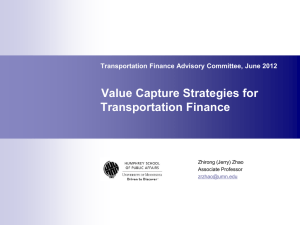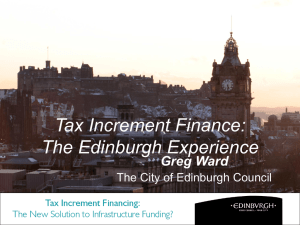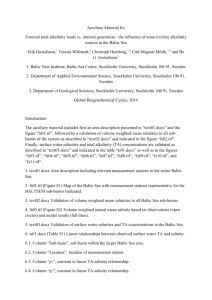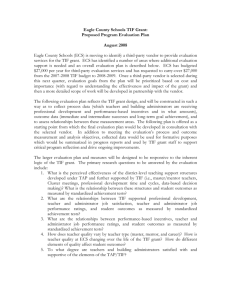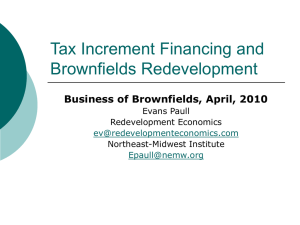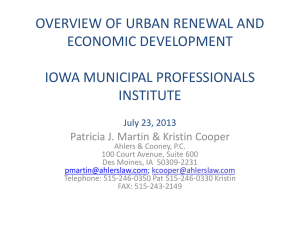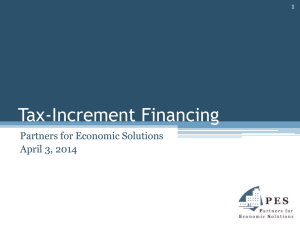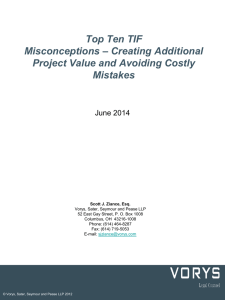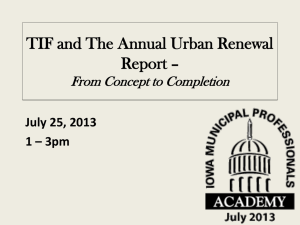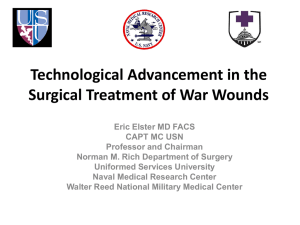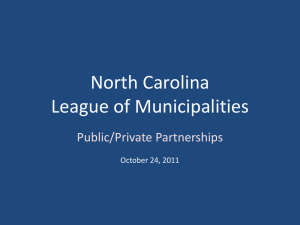apsil m thomas_a - Law Seminars International
advertisement
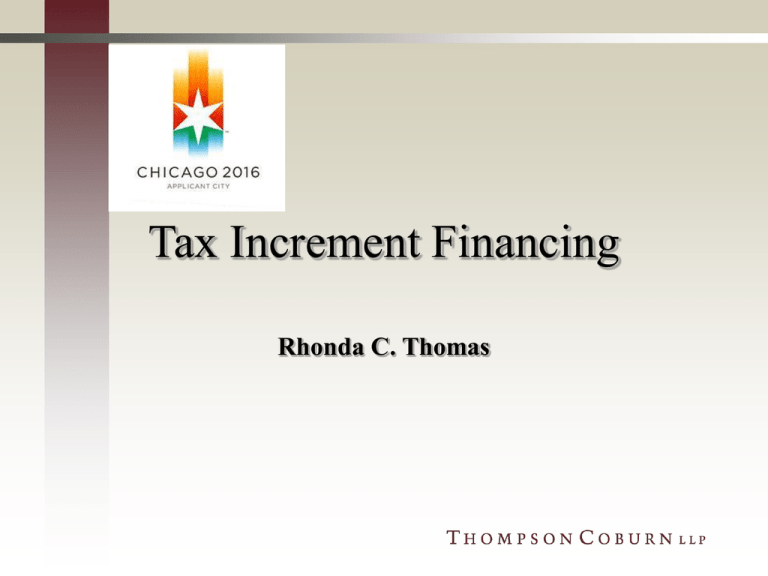
Tax Increment Financing Rhonda C. Thomas Overview of TIF and Other Development Incentives • Form of Public Private Partnership • Uses public tax and fee revenues generated by a development project or • Abate taxes and fees that would otherwise be imposed by government • To provide a source of funding to construct the Project Most Projects Use a Combination of Incentives • Important points in selecting incentives • Understand the tax, fees and other revenues to be generated by Project • Understand the other public benefits of the Project – new jobs, public infrastructure, trigger for redevelopment Selecting a Development Incentive • Statutes restrict availability of incentives • Public Entity must approve • Political environment and local practice • Needs of Project and Attributes of Various Incentives Attributes of Incentive Programs • Revenue Stream that provides incentive – Existing and new property taxes – Existing and new sales taxes - hotel, food and beverage, entertainment – Employment based taxes and fees – head tax, etc. – Special Assessments / special property tax on property benefited by improvements Is it OPM • Other People’s Money – Rebate of Existing Taxes – New Taxes paid by someone other than the Developer – Public entity guarantee Typical Attributes of Incentive Programs • Bond financing capacity – Pay as you go from Incentive Revenues – Issue bonds to provide upfront funding • Tax exempt interest -- lower borrowing costs • Guarantee of bonds by public entity • Power of Eminent Domain to assemble property • Project Costs that can be funded Public Purpose • All incentive programs require a finding of public purpose – can’t use public money for private purpose – Each statute specifies the public purpose findings that must be made – Vary among incentive programs and from state to state Tax Increment Financing – Public Purpose Requirements • Site Conditions – Is the area “Blighted” • “ But-For Test” – would the Project occur without the incentives • Gap Funding - $ amount of incentive required to provide Developer a market return • Extraordinary development costs • Relocation of existing businesses Project Costs • Some incentive programs limited to public improvements • TIF typically can fund certain private project costs • Some incentives do not require a tracing of incentive $ to actual project costs Costs of Studies, Surveys, Development of Plans, and Specifications, Implementation and Administration of the Redevelopment Plan • Architectural, engineering, legal, financial, planning services • No contracts based on percentage of TIF collected or longer than 3 years • No lobbying expenses • Public Entities annual out of pocket administrative costs of the TIF • Costs of Public Entity marketing sites within the Redevelopment Project Area Property Assembly Costs – Acquisition of land and other property, real or personal, or rights or interests therein – Demolition of buildings – Site preparation – Clearing and grading of land – Environmental Clean-up – Relocation Assistance Costs of Construction of Privately Owned Improvements – Costs of rehabilitation, reconstruction or repair or remodeling of existing buildings, fixtures, and leasehold improvements – No funding of costs of construction of new privately-owned buildings Costs of new Public Buildings – Costs of replacing an existing public building demolished to provide site for Redevelopment Project – Funding of costs of parking garages, schools and other public buildings required to serve the TIF Area – No funding of costs of constructing a new municipal public building (not a replacement) principally used to provide offices, storage space, or conference facilities or vehicle storage, maintenance, or repair for administrative, public safety, or public works personnel – Exception if Public Entity finds that the new municipal building is required to meet an increase in the need for public safety triggered by the Redevelopment Project Public Infrastructure / Improvements – – – – Roads, signalization and sidewalks Water and sewer Stormwater detention Public utilities and certain utility extensions for private utilities – No development of a golf course or clubhouse – No development of vacant land designated and used as public land for outdoor “recreational activities” (limited to camping and hunting) or for nature preserves Costs Attributable to an Existing Retail Business – No direct financial support to a retail entity initiating operations in the TIF Area while terminating operations at another Illinois location within 10 miles of the TIF Area in another community – Termination means a closing of a retail operation that is directly related to the opening of the same operation or like retail entity owned or operated by more than 50% of the original ownership – Exception for closing a retail operation for reasons beyond the control of the retail entity – requires a finding that the current location contained inadequate space, had become economically obsolete, or was no longer a viable location for the retailer or serviceman – May only apply to relocation of a business that generates sales tax Developer's Financing Costs – Reimbursement of Developer’s borrowing costs from TIF Revenues may not exceed 30% (75% for TIF funded low income housing Projects) of the annual interest costs incurred by the Developer and of the total costs of the Project – In lieu of reimbursement of financing costs Developer receives a TIF Note which bears interest at a taxable rate equal to the interest costs of the Developer's loan – Expenses related to the issuance of TIF Notes or TIF Bonds - attorneys, TIF consultants, trustees, etc. – Capitalized interest during the estimated period of construction of the Project and for not exceeding 36 months thereafter TIF Projects That Include Housing – 50% of the costs of construction of new housing units to be occupied by low-income households and very low-income households as defined in the Illinois Affordable Housing Act (In lieu of payment of Developer’s financing costs) – School and Library District's increased costs attributable to housing units located within the TIF Area - Reimbursement amount is determined pursuant to a complex formula based on the School District's increase in attendance resulting from the net increase in new students enrolled in the District who reside in housing units within the Redevelopment Project Area or the Library District's increase in persons eligible to obtain a library card in the District who reside in housing units within the Redevelopment Project Area – School and Library Districts may adopt a resolution waiving the right to all or a portion of the reimbursement otherwise required – Acceptance of the reimbursement waives the District's right to directly or indirectly set aside, modify, or contest in any manner the establishment of the Redevelopment Project Area or Projects Costs of Contiguous TIF Areas – Can use TIF Revenues from one TIF Area for eligible costs in a contiguous TIF Area – Contiguous if separated only by a public right of way from the TIF Area from which the TIF Revenues are received – Contiguous if separated only by forest preserve property and the closest boundaries of such TIF Areas are less than one mile apart Payments to School and Other Taxing Districts – All surplus TIF Revenues must be distributed annually within 180 days after the close of the Municipality's fiscal year to the Taxing Districts in the same manner as real property taxes – Guaranteed pass through of a % of the TIF Revenues must be distributed proportionately to all Taxing Districts; i.e. can’t just pass through a % to the School District – Can fund certain Taxing District public improvements (typically Elementary or High School Building or Fire Stations or equipment) – Requires a written agreement with the Municipality and costs must result from the Project Procedures for Use of TIF – Redevelopment Plan – Notice to Property Owners and Taxing Districts – Taxing Districts Committee – Advertised Notice & Public Hearing – Public Entity Approval – Certification to Taxing Authorities – Process takes approximately 6 months TIF Redevelopment Plan Budget – Must include an itemized list of estimated TIF Costs – Should be based on TIF Act categories / not tied to specific Project – Budget should estimate use of all TIF Revenue for 23 year TIF Term / not what Municipality is willing to provide to specific Developer – Footnotes in Plan should authorize • Consumer Price Index growth • Moving costs among categories • Use of TIF Revenues in contiguous TIF Areas pursuant to that contiguous area’s TIF Plan and budget – Budget amendments which increase the total estimated TIF Costs by more than 5% (adjusted for inflation) require the Municipality to give notice, convene a meeting of the Taxing District, and conduct a public hearing Redevelopment Agreement A. Selection of Developer & Approval of Development Agreement B. Property Acquisition & Condemnation C. Performance of Development Project D. Pledge of Revenue Streams E. Issuance of TIF Obligations F. Developer’s/Tenant’s Cooperation in Determining TIF Revenues G. Remedies Form of TIF Reimbursement • TIF Bonds As Source of Construction Financing • TIF Notes with Project Costs Advanced by Developer • TIF Bond Take Out • Share of Incremental Revenue Stream TIF Project Lease Issues • • • • Disclosure of Sales Tax, etc. Operating Covenants, Insurance Non-profit and Service Providers Confidentiality Revenues to Augment TIF Business Districts – Sales Tax, Special Assessments Economic Incentive Agreements – Sales Tax Special Service Areas Security for TIF Bonds Incremental Tax Revenues General Obligation TIF Alternate Bonds – Back Up GO Pledge Developer Guarantee So How Can TIF Fund the 2016 Olympics? • Chicago has an estimated 130 TIF Areas covering 30% of the City • Ability to use TIF Revenues in adjacent TIFs • Chicago has taken a creative approach to the use of TIFs for housing, school construction, etc. Cost of 2016 Chicago Olympics • Total cost estimates of $5 billion • $1.1 billion needed for the lakeside Olympic Village • $366 million for a temporary 80,000 seat Olympic Stadium to be built in Washington Park • City of Chicago has approved a $500 million insurance policy against cost overruns and revenue shortfalls Olympic Funding • Typical Developer Projects to Serve the Olympics - Housing, Retail, Hotel, etc. • Public Infrastructure – roads, utilities, parking • Olympic venues 2016 Olympic TIF Innovations • Chicago school financings • Used TIF to fund public schools • TIF Bonds guaranteed by City of Chicago GO backing • Bonds paid by TIF Revenues where school is located and adjacent TIFs • Similar structure could be used for 2016 Olympic venues 2016 Olympics – A dream for the City of Chicago – TIF can help make the dream come true – Thank you Rhonda Thomas 312.580.2202 Rthomas@tcfhlaw.com
